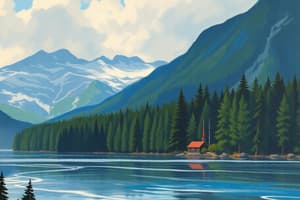Podcast
Questions and Answers
What two statistics are required to determine a community's climate region in Canada?
What two statistics are required to determine a community's climate region in Canada?
Total annual precipitation and January temperature.
How can you differentiate between the Pacific Maritime and Atlantic Maritime climate regions based on January temperature?
How can you differentiate between the Pacific Maritime and Atlantic Maritime climate regions based on January temperature?
If the January temperature is above 0 degrees Celsius, it's Pacific Maritime; if below 0, it's Atlantic Maritime.
What climate region is characterized by annual precipitation between 500-1000 mm and a January temperature below -10 degrees Celsius?
What climate region is characterized by annual precipitation between 500-1000 mm and a January temperature below -10 degrees Celsius?
Boreal climate region.
In terms of climate impact, how does elevation affect temperature?
In terms of climate impact, how does elevation affect temperature?
What role does relief play in determining climate, particularly regarding precipitation?
What role does relief play in determining climate, particularly regarding precipitation?
What are the defining characteristics of a continental climate?
What are the defining characteristics of a continental climate?
Describe the physical characteristics of the Canadian Shield landform region.
Describe the physical characteristics of the Canadian Shield landform region.
How do the landform characteristics of the Great Lakes-St. Lawrence Lowlands differ from those of the Interior Plains?
How do the landform characteristics of the Great Lakes-St. Lawrence Lowlands differ from those of the Interior Plains?
What distinguishes the Western Cordillera from the Appalachian Mountains in terms of geology and topography?
What distinguishes the Western Cordillera from the Appalachian Mountains in terms of geology and topography?
What is a key characteristic of the Innuirian Mountains landform region?
What is a key characteristic of the Innuirian Mountains landform region?
Flashcards are hidden until you start studying
Study Notes
Climate Regions in Canada
- Two key metrics for determining climate regions: total annual precipitation and January temperature.
- Pacific Maritime: Over 1000mm annual precipitation, January temperature above 0°C.
- Atlantic Maritime: Same precipitation, but January temperature below 0°C.
- Southeastern: Annual precipitation between 500-1000mm, January temperature above -10°C.
- Boreal: Same precipitation range with January temperature below -10°C.
- Prairie: Annual precipitation between 250-500mm, January temperature above -20°C.
- Taiga: Same precipitation range but January temperature below -20°C.
- Arctic: Less than 250mm annual precipitation.
Factors that Determine Climate
- Six major factors influencing climate: latitude, ocean currents, winds and air masses, elevation, relief, and proximity to water.
- Latitude: Affects temperature based on sun's energy angle.
- Ocean Currents: Transport warm water to polar regions and cold water towards equator.
- Winds and Air Masses: Bring diverse air types, impacting local weather.
- Elevation: Higher altitudes have lower temperatures.
- Relief: Topography (hills and mountains) causes precipitation by forcing air to rise and cool.
- Proximity to Water: Maritime climates are influenced by ocean, leading to more precipitation compared to continental climates.
Landform Regions
- Regions defined by specific unifying physical or human characteristics provide insights into Earth's landscapes.
- Canadian Shield: Features rounded hills, igneous and metamorphic rocks, and extensive wetlands.
- Interior Plains: Composed of sediments from Canadian Shield and Rocky Mountains, characterized by rolling hills and flat lands.
- Great Lakes-St. Lawrence Lowlands: Dominated by sedimentary rocks, rolling hills, and river valleys resulting from glaciation and erosion.
- Hudson Bay Arctic Lowlands: Composed of sedimentary rocks, including warmer swampy areas and rolling tundra islands.
- Appalachian Mountains: Oldest highland region, with sedimentary and metamorphic rocks, and fertile river valleys.
- Western Cordillera: Features younger, jagged mountains with three subdivisions: coastal range (igneous), interior plateaus (metamorphic), and eastern mountains (metamorphic and sedimentary).
- Innuirian Mountains: Noted for jagged peaks, composed of igneous and metamorphic rocks, situated in isolated, barren, snow-covered land.
Studying That Suits You
Use AI to generate personalized quizzes and flashcards to suit your learning preferences.




